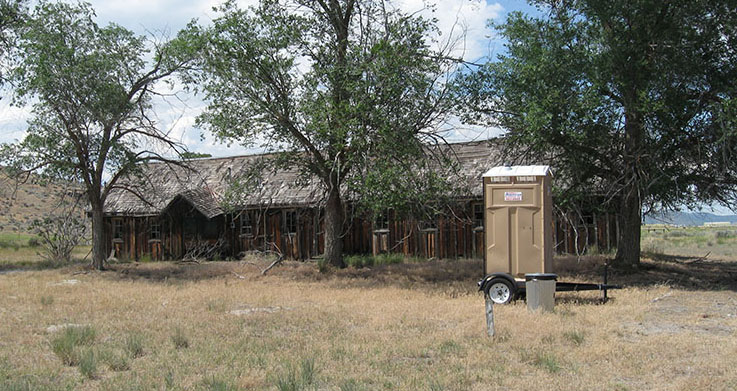
|
UCLA Asian American Studies Center's Suyama Project aims to preserve the history of Japanese American resistance during World War II, including, but not limited to the 100th/442nd Regimental Combat Team draftees, Army and draft resisters, No-Nos, renunciants, and other Nikkei dissidents of World War II. The Suyama Project is made possible through the generous gift of an anonymous donor who wanted to honor and remember the legacy of resistance, broadly understood. |
Tule Lake War Relocation Authority Camp Block 42 Before Tule Lake was converted to a Segregation Center in 1943 for alleged "disloyal" Japanese Americans, Tule Lake was merely one of 10 War Relocation Authority (WRA) camps.
However, the heavy-handed tactics of the Tule Lake WRA director caused tension between the administration and the inmates from early on.

Camp Tule Lake
In 1943, the War Department and the War Relocation Authority (WRA) issued separate but similar loyalty questionnaires to the inmates that were poorly worded.
The War Department's goal was to identify alleged "loyal" Japanese American men who were of draft age. The WRA's objective was to start releasing alleged "loyals" from the WRA camps.
The War Department's form was given to Japanese American men and titled, "Statement of United States Citizens of Japanese Ancestry," DSS Form 304A. Answering this Selective Service form was voluntary.
The WRA form was given to all adult Japanese Americans in the camps and titled, "Application for Leave Clearance," Form WRA-126, Rev. Answering this form was compulsory.
The title of the two forms, the wording of the questions and the issue over whether the forms were voluntary or compulsory caused confusion among all 10 WRA camp inmates.
At Tule Lake, relations between the administration and inmates deteriorated when the administration failed to provide basic information such as why the inmates were required to register for the so-called loyalty questionnaire.
Tensions increased when the Tule Lake project director announced through the camp newspaper, the Tulean Dispatch, that anyone who interfered with the registration process would be fined up to $10,000 and/or imprisoned up to 20 years under the Espionage Act.
On or about Feb. 15, 1943, the men in Block 42 were ordered to register for the Selective Service. According to statements given by the men, a WRA representative visited Block 42 and told them if they chose to expatriate/repatriate to Japan, they would not have to register.
Several Block 42 men decided to apply for expatriation/repatriation. Many of these men had already applied for Selective Service and felt it unnecessary and even insulting to apply a second time. Some, who had registered before the war, had been given deferments for operating a farm, while others, who registered right after Japan's attack on Pearl Harbor, had been reclassified as enemy aliens.
On Feb. 19, a group of Block 42 men went to the Administration building and handed papers for expatriation/repatriation. A crowd started gathering around the Block 42 men but the incident ended without any problems.
The administration, however, took action against the Block 42 men on Feb. 21. Roughly 35 men from Block 42 were rounded up after dinner. One group was sent to the Klamath Falls jail and another, to the Alturas jail. Both groups were imprisoned for about seven days with no charges, no hearing or trial.
Meanwhile, the public arrest of the Block 42 men caused chaos in camp. Some in Tule Lake registered out of fear, while others became more defiant. The inmate-organized Planning Board and Community Council urged the Tule Lake administration to release the Block 42 men and proposed new registration procedures but the administration took a hard stance and refused to compromise.
About a week after their arrest, the two group of Block 42 men were reunited at a former Civilian Conservation Corps (CCC) camp named Camp Tulelake, located about 10 miles from the Tule Lake WRA camp.
One night, the Block 42 men were roused out of bed in the dead of night and ordered to stand outside the CCC barracks, according to brothers Mori and James Tanimoto, who were among the detained Block 42 men. Soldiers with rifles stood on both sides of a flood light focused on the men. The Tanimoto brothers thought they were facing a firing squad.
Although this incident ended with no injuries, the Tanimoto brothers speculated that the soldiers had intended to scare the men into answering the so-called loyalty questionnaire because shortly after this, on March 30, hearings were held.
A Caucasian recreation hall served as the court room. The men were not given legal counsel, and alleged leaders were charged with one count of refusing to comply with the WRA's and not the War Department's order to register and one count of conspiring to impede the registration.
These alleged leaders were all shipped to the Moab Citizen Isolation Center where they were imprisoned for another four months.
The remaining Block 42 men were returned to Tule Lake about a month after their arrest. Unbeknownst to the Block 42 men and the other Tuleans, the administration had no legal authority to arrest the men. The War Department and the FBI had informed the Tule Lake administration that refusing to answer the loyalty questionnaire was not a violation of the Selective Service Act or the Espionage Act and did not carry a $10,000 fine and/or 20 years in jail. This information would not become public until decades later.
Ultimately, the Tule Lake administration's hardline approach towards the Tuleans contributed to the high number of inmates refusing to register.
According to "The Evacuated People: A Quantitative Description" publication by the WRA, there were 77,842 inmates eligible to register for the questionnaire from all the 10 WRA camps. Of the 77,842 eligible, 3,254 did not register. Of the 3,254 who did not register, 3,218 were from Tule Lake.
As a result, the government chose to convert Tule Lake into a Segregation Center in the fall of 1943. For more information:Collins, Donald. Native American Aliens: Disloyalty and the Renunciation of Citizenship by Japanese Americans During World War II. Westport, Connecticut: Greenwood Press, 1985.
Weglyn, Michi. Years of Infamy: The Untold Story of America's Concentration Camps. New York: Morrow, 1976. Updated ed. Seattle: University of Washington Press, 1997. |